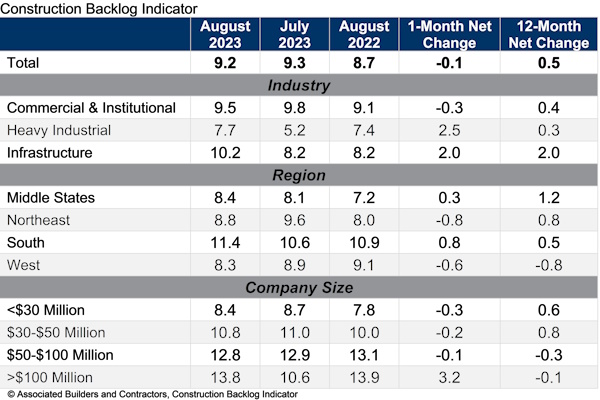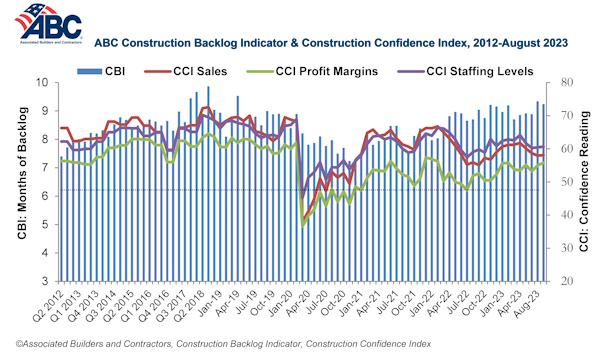Associated Builders and Contractors' Construction Backlog Indicator declined to 9.2 months in August, down 0.1 month, according to an ABC member survey conducted from Aug. 21 to Sept. 6. The reading is 0.5 months above the August 2022 level.
Backlog decreased on a monthly basis for all categories of company size except for those with more than $100 million in annual revenues, while only the smallest two revenue categories have higher backlog than in August 2022.
ABC’s Construction Confidence Index reading for sales, profit margins and staffing levels moved higher in August. All three readings remain above the threshold of 50, indicating expectations of growth over the next six months.
“There’s no sign of a construction recession in the near term,” said ABC Chief Economist Anirban Basu. “If anything, contractors are more upbeat, as policy and technology shifts along with economic transformation, are creating substantial demand for improvements and growth in America’s built environment.
“While a plurality of contractors expects only small improvements in sales, profit margins and staffing over the next six months, even incremental improvement is remarkable in the context of tightening credit, higher project financing costs and lingering fears of recession,” said Basu. “Backlog continues to be at the upper end of historic levels, with the infrastructure category registering substantial gains in backlog in August. That suggests that a growing number of public works projects is poised to break ground.”


Related Stories
| Aug 11, 2010
2009 Judging Panel
A Matthew H. Johnson, PE Associate Principal Simpson Gumpertz & HegerWaltham, Mass. B K. Nam Shiu, SE, PEVP Walker Restoration Consultants Elgin, Ill. C David P. Callan, PE, CEM, LEED APSVPEnvironmental Systems DesignChicago D Ken Osmun, PA, DBIA, LEED AP Group President, ConstructionWight & Company Darien, Ill.
| Aug 11, 2010
Inspiring Offices: Office Design That Drives Creativity
Office design has always been linked to productivity—how many workers can be reasonably squeezed into a given space—but why isn’t it more frequently linked to creativity? “In general, I don’t think enough people link the design of space to business outcome,” says Janice Linster, partner with the Minneapolis design firm Studio Hive.







